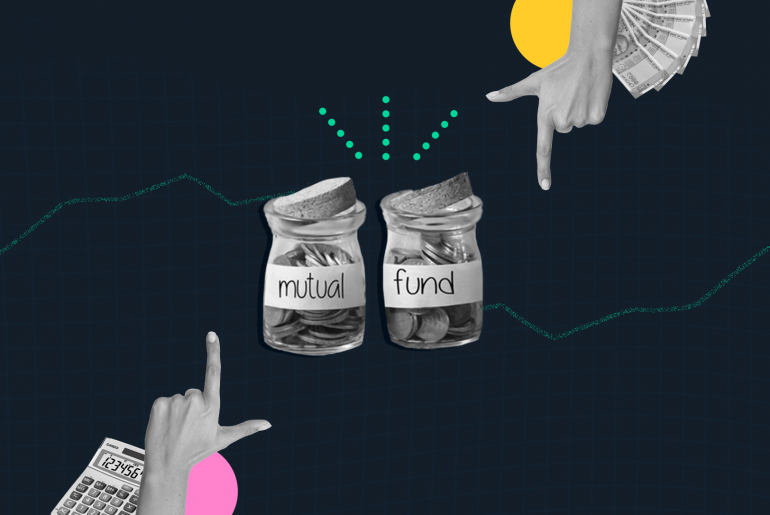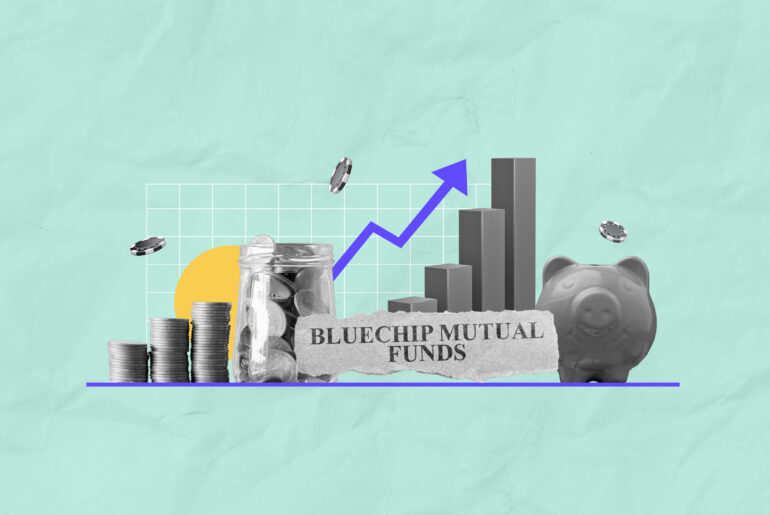Last Updated on May 9, 2025 by vanessa sequeira
The investment world offers investors a plethora of options and opportunities to grow wealth. A popular investment vehicle is bond funds. These funds are a kind of mutual fund that largely invests in fixed income securities like government and corporate bonds. But what are bond funds? How are they different from bonds? Is there any risk involved? Let us find out.
Table of Contents
List of Bond Funds
| Name | Sub Category | AUM | CAGR 3Y | Expense Ratio | CAGR 5Y |
| UTI Dynamic Bond Fund | Dynamic Bond Fund | 465.14 | 8.21 | 0.71 | 9.66 |
| Aditya Birla SL Dynamic Bond Fund | Dynamic Bond Fund | 1,836.65 | 9.80 | 0.64 | 8.62 |
| ICICI Pru All Seasons Bond Fund | Dynamic Bond Fund | 14,362.97 | 9.30 | 0.59 | 7.95 |
| HDFC Dynamic Debt Fund | Dynamic Bond Fund | 798.68 | 8.72 | 0.75 | 7.94 |
| Axis Corp Bond Fund | Corporate Bond Fund | 6,773.20 | 8.26 | 0.32 | 7.66 |
| Kotak Dynamic Bond Fund | Dynamic Bond Fund | 2,825.57 | 9.01 | 0.58 | 7.63 |
| 360 ONE Dynamic Bond Fund | Dynamic Bond Fund | 706.72 | 8.54 | 0.27 | 7.61 |
| Nippon India Corp Bond Fund | Corporate Bond Fund | 6,998.47 | 8.38 | 0.36 | 7.52 |
| Aditya Birla SL Corp Bond Fund | Corporate Bond Fund | 25,884.32 | 8.23 | 0.33 | 7.33 |
| ICICI Pru Corp Bond Fund | Corporate Bond Fund | 31,133.02 | 8.18 | 0.35 | 7.31 |
Disclaimer: Please note that the above table is for educational purposes only, and is not recommendatory in nature. Please do your own research or consult your financial advisor before investing.
Note: The data on this list of overnight mutual funds is from 8th May 2025 and derived using Tickertape Mutual Fund Screener
What Is A Bond Fund?
A bond fund is a debt fund that invests 80% of its portfolio in different kinds of bonds like government securities and corporate bonds. It is a pooled investment with the convenience of professional selection and portfolio management. Some portion of the portfolio can be invested in the money market, generally, to meet the liquidity requirements.
The portfolio is sufficiently diversified to minimise credit risk. Its structure diversifies risk inexpensively. With bond funds, investors have the opportunity to collect interest income, dividends, and long-term capital gains (LTCG), or reinvest them back into the fund to increase the principal amount that will earn interest.
Types of Bond Funds
Bond investment funds are broadly classified based on the credit quality of the instruments and their maturity profiles.
- Corporate Bond Funds: These funds allocate at least 80% of their assets to high-rated corporate debt instruments. They focus on delivering relatively stable returns by investing in companies with strong credit ratings.
- Government Bond Funds (Gilt Funds): These invest in sovereign securities issued by the government. While they carry minimal credit risk, they can be sensitive to interest rate fluctuations.
- Dynamic Bond Funds: These funds actively adjust their portfolio duration in response to changing interest rate scenarios. They invest across short-term and long-term debt instruments without restriction.
- Credit Risk Funds: These carry higher credit risk as they invest a substantial portion in lower-rated corporate bonds, aiming for higher yields.
- Short-Term and Ultra-Short-Term Bond Funds: These focus on debt bond funds with shorter maturities. They suit investors with a low-risk appetite and a short investment horizon.
Features of Bond Funds
Bond fund investments are preferred by conservative investors seeking relatively predictable income and capital preservation. Here are some notable features:
- Professional Management: Bond mutual funds for SIP are managed by fund managers and an investment team who buy and sell bonds according to market conditions and the objectives of the fund. There is no compulsion for them to hold the bonds till maturity.
- Diversification: Many investors find a bond fund more efficient than individual bond securities as it provides instant diversification with minimum investment apart from liquidity.
- Liquidity:You can sell bond investment funds whenever you want for their prevalent market net asset value (NAV) that brings capital gain or loss. Note that a fund’s NAV fluctuates in response to interest rates, credit quality, currency values, and overall cash flows of bond funds.
- Interest Rate Sensitivity: Bond fund NAVs are influenced by interest rate movements. Typically, bond prices fall when interest rates rise, and vice versa.
- Credit Risk: While corporate bond funds mostly invest in high-rated instruments (AA+ and above), other bond funds like credit risk funds carry a higher probability of default.
- Regular Income Potential: These funds may provide high-return bond funds in the form of dividends or capital appreciation, although payouts are not guaranteed
Who Should Invest In Bond Funds?
Investors with a low-risk profile who want regular returns but without equity exposure generally prefer to invest in debt bond funds. You can purchase low-risk bond funds if you prefer stable returns over possible but uncertain capital appreciation in the equity market.
The Measure Of Bond Fund Performance
The performance of a bond fund, like all funds, depends on its underlying assets. There are certain other factors too that affect its performance. The past performance of a fund is not a guarantee of future results.
- Share price: Every fund has a NAV which represents the value of one share of the fund that fluctuates daily.
- Yield: The yield is the income generated by the underlying bonds in the fund. Based on the 30-day annualised yield, one can check the fund’s average yield to know the yield potential of the fund.
Bonds Vs. Bond Funds
Bond funds differ from individual bonds in several ways. Have a look at this table for a better understanding.
| Bonds | Bond Funds | |
| Maturity Date | Defined | Undefined |
| Redemption | At par on maturity | At current NAV |
| Variables Affecting Investment | – Interest rate risk reduces as the bond maturity date is near – Affected hugely from default | – Constant interest rate risk – The lesser impact from the default |
| Liquidity | Only high quality and popular bonds are easy to liquidate | Generally highly liquid |
| Fees | Commission added to the cost of purchase | Annual management fees and sales commission |
| Types | Vary by issuer, maturity, credit quality, interest rate | Dynamic bond Funds, Income funds, term-based, strategy or investment objective-based, etc. |
Why Do Investors Prefer Bond Funds?
- Easier to invest: Most investors find bond funds attractive investment options as these are easier to invest in than individual bonds. You get professional assistance from portfolio managers.
- Liquidity: Bond funds offer high liquidity. However, a fund’s liquidity is affected by supply and demand, and the credit of the fund company.
- Easy accessibility: You can explore bond funds for long-term investment directly from the fund company through brokers or banks. You can do this via unit investment trusts, open-end funds, closed-end funds, ETFs (exchange-traded funds), and money market funds.
- Quick diversification: Since debt bond funds are diversified investments with a pool of different bonds, they minimise the risk involved. Even if one or two bonds do not perform well, your monthly interest from the fund does not get impacted hugely.
- Cost-efficiency: Bond investment funds result in cost efficiency as an investor only pays the annual expense ratio that includes marketing cost, administrative cost, and professional management fees.
Risks Associated With Bond Funds
- Interest rate risk: Bond price and interest rate carry an inverse relationship. If there is an increase in interest rate, bond prices in the open market reduce, and if interest rates decline, bond prices increase. To understand this relationship, you can see that the longer the maturity period, the higher the interest rate risk because its net asset value (NAV) reacts greatly to the change in prices of the underlying bonds.
- Credit risk: A bond fund can be of medium-to-high credit quality or low-investment-grade quality, based on the underlying bonds in the fund. Rating agencies rate these bonds to help investors in identifying the issuer’s creditworthiness. You can find many fund managers investing in high-yield bond funds that are lower-quality bonds. Therefore, bond funds are subject to credit risk.
- Principal risk: You sell your share in a bond fund at the fund’s current NAV. NAV is determined by dividing the total value of all holdings in the fund by the number of fund shares. If the fund’s NAV was higher on the day you bought it than its current NAV, you would be at a loss of some of your initial investment.
Taxation Rules Of Corporate Bond Mutual Funds
The taxation on corporate bond mutual funds is as follows:
- Short-Term Capital Gains (STCG): Irrespective of the holding period, gains from corporate bond funds are now treated as short-term capital gains. They are added to the investor’s income and taxed as per the applicable income tax slab.
- Long-Term Capital Gains (LTCG) with Indexation Removed: Earlier, debt mutual funds (including corporate bond funds) held for over three years were eligible for LTCG taxation at 20% with indexation benefits. This benefit has now been removed. All gains are taxed according to the slab rate, even for long-term holdings.
- Dividend Distribution Tax (DDT): DDT has been abolished. Dividends received from corporate bond funds are now taxed in the hands of the investor as per their income slab.
Conclusion
Investing in long-term bond funds can offer better liquidity, diversification and cost-efficiency. A bond fund that largely invests in government securities, debentures, and corporate bonds can effectively hedge your portfolio against market risks besides offering stable returns. Talk to your financial advisor before investing in an investment vehicle.
Frequently Asked Questions About Bond Funds
1. What is the investment tenure of a corporate bond?
Corporate bonds typically have tenures ranging from 1 to 10 years, though some can extend beyond that. The exact tenure depends on the issuing company and the bond’s structure.
2. Are corporate bonds profitable?
Corporate bonds can be profitable, offering higher returns than government bonds or FDs, especially if issued by high-rated companies. However, the risk of default or interest rate changes can impact profitability.
3. Which is better, FD or bonds?
Fixed Deposits (FDs) offer capital safety with predictable returns, while bonds—especially corporate bonds—may provide higher returns but carry varying degrees of risk. The better choice depends on your risk appetite and investment goals.
4. What are the best bond funds?
Some of the best performing bond funds according to 3Y CAGR are:
– Kotak Nifty SDL Apr 2032 Top 12 Equal Weight Index Fund
– Nippon India Corp Bond Fund
– Axis Corp Bond Fund
– Aditya Birla SL Corp Bond Fund
– HDFC Corp Bond Fund
Note: This list is for educational purposes and is not recommendatory in nature.
5. Which bonds give the highest return?
Here are some of the top bond funds according to 3Y Average Rolling Returns:
– UTI Dynamic Bond Fund
– Kotak Nifty SDL Apr 2032 Top 12 Equal Weight Index Fund
– Aditya Birla SL Dynamic Bond Fund
– Tata Nifty SDL Plus AAA PSU Bond Dec 2027 60:40 Index Fund
– SBI Dynamic Bond Fund
Note: This list is for educational purposes and is not recommendatory in nature.
- How To Declare Mutual Funds in ITR & Disclose Capital Gains in India? - Jun 6, 2025
- How To Sell or Exit Your Mutual Funds in India? - Jun 6, 2025
- Fund of Funds (FOF): Meaning, Types & Advantages - May 13, 2025





